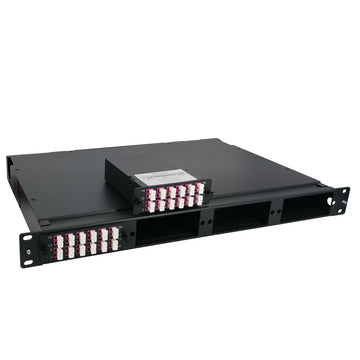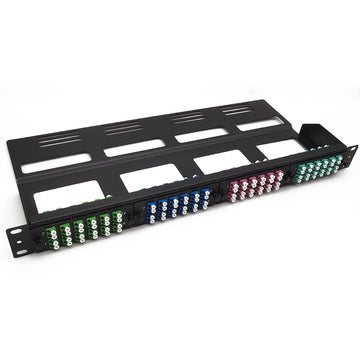800G Optical Transceiver Demand Surges with Advancements in AI Computing
In the ever-evolving landscape of information technology, the demand for high-speed and high-capacity data transmission has become more critical than ever. Artificial Intelligence (AI) computing, with its complex algorithms and data-intensive processes, has emerged as a key driver in this paradigm shift. This article explores the surge in demand for 800G optical transceivers, propelled by the rapid growth of AI computing applications.
AI Computing Drives the Rise of 400G/800G Optical Transceivers
Artificial Intelligence (AI), encompassing machine learning and deep learning, has become integral to various industries, ranging from healthcare and finance to manufacturing and entertainment. These AI computing applications involve processing massive datasets and executing complex computations in real time. As the scale and intricacy of AI models increase, traditional networking infrastructure struggles to keep pace with the demand for data transmission.
To address this challenge, there has been a significant push towards higher-speed optical transceivers. The transition from 100G to 400G and now 800G optical transceivers is driven by the need for faster and more efficient data transfer within data centers and across networks. The higher data rates enable AI systems to exchange information swiftly, facilitating quicker decision-making and enhancing overall performance.
800G Transceiver Overview: QSFP-DD and OSFP Packages

800G QSFP-DD Form Factor:
Dual-density four-channel small pluggable high-speed module. QSFP-DD is currently the preferred package for 800G optical modules, enabling data centers to efficiently grow and scale cloud capacity as needed. The QSFP-DD module uses 8-channel electrical interfaces with rates up to 25Gb/s (NRZ modulation) or 50Gb/s (PAM4 modulation) per channel, providing solutions up to 200Gb/s or 400Gb/s aggregation.
The Advantages of 800G QSFP-DD:
1. With backward compatibility, compatible with QSFP+/QSFP28/QSFP56 QSFP package.
2. Adopt 2×1 stacked integrated cage and connector, can support single height and double height cage connector system.
3. With SMT connectors and 1xN cages, cage design and optical module housing optimization enable a heat capacity of at least 12 watts per module. The higher heat capacity can reduce the heat dissipation function requirements of the optical module, thus reducing some unnecessary costs.
4. In the design of QSFP-DD, the MSA working group fully considered the flexibility of user use, adopted the ASIC design, supported a variety of interface rates, and could be backward compatible (compatible with QSFP+/QSFP28), thus reducing port costs and device deployment costs.
800G OSFP Form Factor:
The OSFP is a new type of optical module, much smaller than the CFP8 but slightly larger than the QSFP-DD, with eight high-speed electrical channels that still support 32 OSFP ports on each 1U front panel. With an integrated heat sink, it can greatly improve heat dissipation performance.
The Advantages of 800G OSFP:
1. The OSFP module is designed as an 8-channel (Octal, or 8 lane), directly supporting a total throughput of up to 800G, enabling higher bandwidth density.
2. Because the OSFP package supports more channels and higher data transfer rates, it can provide higher performance and longer transmission distances.
3. OSFP module has excellent thermal design and can handle higher power consumption.
4. OSFP is designed to support higher rates in the future. Due to the larger size of the OSFP module, it has the potential to support higher power consumption and thus higher rates, such as 1.6T or higher.
How to Choose 800G Transceiver for Your Data Center?
To choose the right 800G transceiver for your network application, it is essential to carefully evaluate various factors, including transmission distance, fiber type, form factor…
The 800G OSFP module is suitable for network environments that require high bandwidth and large capacity data transmission, such as data centers, cloud computing, and ultra-large-scale networks.
The 800G QSFP-DD module is suitable for high-speed network environments, such as data centers, cloud computing, and large-scale networks, to meet the demand for high bandwidth and large-capacity data transmission.
| Form Factor | Configuration | Application | Connector | Max Reach | Wavelength | Part Number |
|---|---|---|---|---|---|---|
| OSFP | 2x400Gb/s 2xSR4 |
8x100G-PAM4 electrical to Dual 4x100G-PAM4 optical Parallel |
Dual MPO-12/APC | 50m | 850nm multi-mode | MMA4Z00-NS (Finned top) |
| OSFP | 2x400Gb/s 2xDR4 |
8x100G-PAM4 electrical to Dual 4x100G-PAM4 optical Parallel |
Dual MPO-12/APC | 500m | 1310nm single-mode | MMS4X00-NS (Finned top) |
| OSFP | 2x400Gb/s 2xDR4 |
8x100G-PAM4 electrical to Dual 4x100G-PAM4 optical Parallel |
Dual MPO-12/APC | 2km | 1310nm single-mode | MMS4X00-NM (Finned top) |
| OSFP | 2x400Gb/s 2xFR4 |
8x100G-PAM4 electrical to Dual 4x100G-PAM4 optical Multiplexed |
Dual LC Duplex | 2km | 1310nm single-mode | MMS4X50-NM (Finned top) |
| OSFP | 2x400Gb/s 2xLR4 |
8x100G-PAM4 electrical to Dual 4x100G-PAM4 optical Multiplexed |
Dual LC Duplex | 10km | 1310nm single-mode | OSFP-800G-2LR4 |
| QSFP-DD | 8x100Gb/s SR8 | 800G | MPO-16/APC | 50m | 850nm multi-mode | QDD-800G-SR8 |
| QSFP-DD | 8x100Gb/s XDR8 | 2x 400G XDR4 or 8x 100G FR | MPO-16/APC | 2km | 1310nm single-mode | QDD-800G-XDR8 |
| QSFP-DD | 8x100Gb/s PLR8 | 2x 400G PLR4 or 8x 100G LR | MPO-16/APC | 10km | 1310nm single-mode | QDD-800G-PLR8 |












